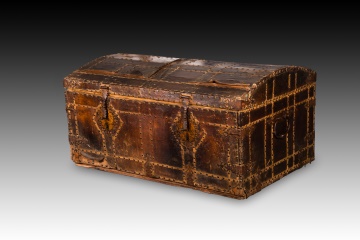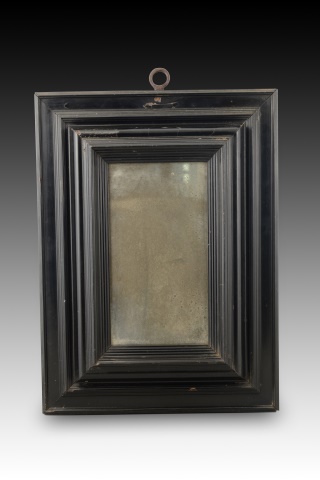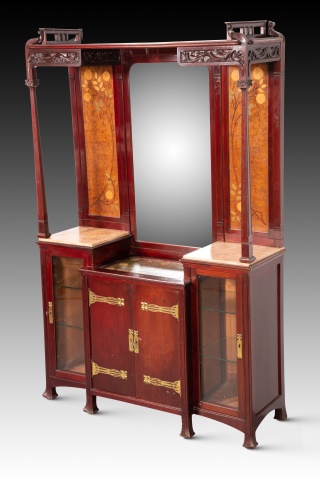Results 97 to 114 of 114
«« « 12345 » »»
-
Chest of drawers. Lemongrass wood. 19th century. A chest of drawers made of lemongrass wood with a straight, rectangular top and five drawers at the front (two narrow and three long), decorated with simple flat mouldings and spherical legs. This decorative simplicity, which highlights the quality and grain of the lemongrass wood finish, is reminiscent of English examples.
· Size: 103x49x106 cms.
ANTIQUES
FURNITURE
Ref.: Z0312
-
Chest. Walnut wood, iron. Burgos, 17th century. Rectangular chest with a flat lid made of carved walnut wood, with corners and a latch at the front to lock it with a key, and a carved decoration on the bottom with simple geometric elements, and simple lines on the outer edge of the lid. This type of furniture was very common in Spain, frequently used to store objects of a certain value such as clothes, dishes, etc.
· Size: 169x52x73 cms.
ANTIQUES
FURNITURE
Ref.: Z4841
-
Gaming table with marquetry. Rosewood, mahogany, fruitwood, bronze, leather. 19th century. Table with four fluted legs with metal elements towards the top that has a delicate marquetry decoration (flowers, bows, plant elements) on the main front and on an outer band on the top board, an area in which another simpler geometric marquetry is presented. It has a large drawer, and can be opened to play, leaving a more resistant textile finish on the top. Stylistically, the influence of classicist models is clear in the piece, responding to the norms and tastes of Neoclassicism. This type of piece was relatively common in the interiors of the upper bourgeoisie, designed to be placed against a wall when not in use and to enhance the decorative function of the piece while taking up less space, thus promoting the functional aspect of the table.
· Size: 88x43x76 cms.
ANTIQUES
Ref.: ZF0503
-
Cornucopia. Gilded wood. 18th century. Rectangular cornucopia with a carved and gilded wooden frame decorated with a series of smooth mouldings and a very elaborate top (arranged in a symmetrical composition, architectural and plant elements, scrolls, etc. can be seen). Although the smooth mouldings are very classicist details common in Neoclassicism, the lines, curves and movement of the top are characteristic of Rococo. The combination of both styles of the 18th century is common both in Spanish furniture and in other schools. Requires restoration.
· Size: 33.5x4x57.5 LUZ 27x19 cms.
ANTIQUES
Ref.: Z0311
-
Side table or “guéridon”. Mahogany, gilt bronze, onyx (possibly from Algeria). France, towards the end of the 19th century. Octagonal mahogany side table with a top made of light-coloured onyx or onyx. It has four legs joined at the bottom with a curved frame, which are joined in a central piece topped by a small vase-shaped piece. At the waist, gilded bronze applications of a classicist influence can be seen between the cubes that finish off the legs, which are decorated with bronze applications. Between each two legs there is a wooden pendant. There are known examples preserved in private collections of French furniture with onyx tops, of similar colours to this one, from Algeria. Stylistically, the table shows a strong French and neoclassical influence, with elements (the pendants) considered to have an orientalist touch.
· Size: 62,5x62,5x69 cms
ANTIQUES
Ref.: ZF1263
-
Monk's armchair. Walnut wood, textile. Spain, 17th century. Armchair with arms and high backrest, of the type known as “frailero”, which has a textile upholstery with studs on the seat and backrest, low, cut-out profile jambs joining the front and back legs and middle jambs or smooth crossbars joining the two front and two back legs, and simple armrests (curved, ending in scrolls). The frailero armchair, originally of Italian origin, became one of the most common pieces of Spanish furniture since its introduction in the 16th century, being characteristic of both the 17th and 18th centuries and being recovered again in the historicist movement of the 19th century. Being such a deep-rooted tradition in Spain, this type of model was never stopped being created.
· Size: 74x67x128 cms.
ANTIQUES
Ref.: Z0665
-
Monk's armchair. Walnut wood, textile, metal. Spain, 16th century. It has defects. Armchair with arms and high backrest, of the type known as “frailero”, which has a textile upholstery with studs on the seat and backrest, low, cut-out low-profile chambranes joining the front and back legs and middle chambranes or side rails (the front with carved geometric motifs) joining the two front and two back legs, and simple armrests (curved, ending in scrolls; the front with fluting). The friar's chair, initially of Italian origin, became one of the most common pieces of Spanish furniture since its introduction in the 16th century, being characteristic of both the 17th and 18th centuries and being recovered again in the historicist movement of the 19th century. Being such a deep-rooted tradition in Spain, this type of model was never stopped being created.
· Size: 62,5x55x126 cms.
ANTIQUES
Ref.: Z0667
-
Standing dressing table mirror in carved mahogany, 19th century. The rectangular mirror frame is decorated with scrolls and carved floral and plant motifs in the classical tradition, and rests on two curved legs with lines reminiscent of the characteristic movement of the Baroque and Rococo periods. This mixture of styles was common in 19th century furniture, as shapes from past traditions were chosen for the creations of the period.
· Size: 88x76x160 cms.
ANTIQUES
FURNITURE
Ref.: Z2515
-

Trunk. Wood, leather, iron. Spanish School, around 1700. Wooden trunk with a curved lid and rectangular shape, covered with leather on the outside, with fittings, handles, studs and two closures at the front, which has a front and top opening. Inside it has a lower space accessible from the front divided in two by a vertical piece of wood; the lid and part of the chest have a textile covering. The back does not have leather. The nails with circular heads are arranged in geometric shapes. The handles have disc decorations. The fittings, also worked, follow models based on architectural designs, motifs also present in the lock shields on the front. Some of the metal elements still have traces of gilding. These types of trunks were known as “travel trunks” because they were normally used to store objects on journeys, hence the leather covering and the apparent lack of decoration on the outside. Having two locks was for greater security, since the two keys had to be used together to open it and these were usually entrusted to two different people. Compare this with the 17th century travel trunk from the Viceroyalty of Peru in the Museum of America (Madrid), which has decoration with animals and plant motifs (embossed leather). Or with the Chest of the Mayorazgo de la Cerda (17th century) in the National Museum of Decorative Arts (Madrid).
· Size: 85x129x65 cms.
ANTIQUES
Ref.: ZF1245
-
Winged table with turned legs. Walnut wood. Spanish school, 18th century. A folding round table with two wings that can be folded down and supported by two legs joined together for each wing by means of lower jambs. When the table is folded, there is a drawer with a wooden knob on each side and two legs on each side, joined in a rectangle by means of a jamb. The legs and vertical elements of the piece of furniture have turned balustrade elements and discs, as is usual in the Spanish school since the Baroque.
· Size: 107x 37x76 cms / Abierta 107x103x76 cms.
ANTIQUES
Ref.: ZF1173
-
Table with lentil leg and inlay. Rosewood. 18th century. Table with four turned disc legs (of the type known as lentil legs) joined two by two by means of a jamb with the same decorative element, which has iron fasteners decorated with discs and a rectangular top decorated with wood marquetry in different shades based on plant elements, circles and smooth areas.
· Size: 83x53x55 cms.
ANTIQUES
Ref.: Z6116
-
Monk's armchair. Walnut wood, leather. Spain, 16th century. Armchair with arms and high backrest of the type known as “friar's chair”, which has leather with studs on the seat and upper part of the backrest, very low chambranes joining the front legs with the back ones and middle chambranes or side rails (the front one carved with a relief of floral motifs flanking an empty heraldic shield in the round) joining the two front legs and the two back ones, and simple armrests, with the fluted fronts following architectural influences. The friar's chair, initially of Italian origin, became one of the most common pieces of Spanish furniture since its introduction in the 16th century, being characteristic of this and the 17th century and being recovered again in the historicist movement of the 19th century. Being such a deep-rooted tradition in Spain, this type of model was never stopped being created. Requires restoration.
· Size: 65,5x53x109 cms.
ANTIQUES
Ref.: Z0706
-
Sold

Frame with mirror. Ebonized wood, glass. 17th century. It has faults. Rectangular frame made of carved and ebonized wood decorated with a series of smooth mouldings of different widths and depths. The mirror plate is also old and still has a metal piece on the back for hanging it on the wall. Stylistically, it is more reminiscent of Italian examples than Flemish ones, although this way of making frames was very popular in practically all European schools. Weight: 3 kg.
· Size: 37,5x7x51cms. int: 17,5x31,5 cms.
ANTIQUES
Ref.: ZF1260
-
Sold

Art Nouveau furniture. Wood, glass, metal, etc. Circa 1900. Tall wall cabinet with a mirror on the top and drawers below (two display cabinets on the sides with transparent glass doors and another space with shelves in the centre, all three with a lockable key), decorated with carvings, appliqués and shapes reminiscent of plants, with delicate curves and great attention to detail. Due to its decorative elements (flowers, leaves, etc.) it is considered to be part of Modernism, a style highly appreciated in Europe that reached its peak around 1900.
· Size: 119x36,5x180 cms.
ANTIQUES
Ref.: ZF1292
-
Monk's armchair. Wood, leather. Spain, 16th and 18th centuries. Armchair with arms and high backrest of the type known as “friar’s chair”, which has leather with studs on the seat and upper part of the backrest, low, cut-out low-profile chambranes joining the front and back legs and middle chambranes or side rails (the front one carved with a relief of architectural motifs) joining the two front and two back legs, and simple armrests. In this case, it should be noted that the chambrane, due to the relief, would be from the 18th century. The friar’s chair, initially of Italian origin, became one of the most common pieces of Spanish furniture since its introduction in the 16th century, being characteristic of this and the 17th century and being recovered again in the historicist movement of the 19th century. Being such a deep-rooted tradition in Spain, this type of model was never stopped being created.
· Size: 57,5x54x113 cms.
ANTIQUES
Ref.: Z0672
-
Monk's armchair. Leather, walnut wood. Spain, 16th century. Armchair with arms and high backrest of the type known as “friar's chair”, which has leather with studs on the seat and upper part of the backrest, low, cut-out low-profile frames joining the front and back legs and middle frames or side rails (the front one carved and re-cut to create geometric motifs) joining the two front and two back legs, and simple armrests with scrollwork finishes. The friar's chair, originally of Italian origin, became one of the most common pieces of Spanish furniture since its introduction in the 16th century, being characteristic of both the 17th and 18th centuries and being recovered again in the historicist movement of the 19th century. Being such a deep-rooted tradition in Spain, this type of model was never stopped being created.
· Size: 61x54x111 cms.
ANTIQUES
Ref.: Z0673
-
Stool. Walnut wood. 18th century. Rectangular bench with smooth moulding on the edge and turned baluster-shaped legs, which are secured in the lower area by means of cut-out profile jambs on the bottom. It shows classicist influences, present together with traditional elements of older Spanish furniture (format, construction, etc.).
· Size: 52x34,5x50 cms.
ANTIQUES
Ref.: ZE331
-
Monk's armchair. Leather, walnut wood. Spain, 16th century. It has faults. Armchair with arms and high backrest of the type known as “friar's chair”, which has leather with studs on the upper part of the backrest (lack of the seat), low, low-profile trimmed jambs joining the front and back legs and middle jambs or side rails (the front one carved and re-cut to create geometric motifs) joining the two front and two back legs, and simple armrests with raised scrollwork finishes. The friar's chair, originally of Italian origin, became one of the most common pieces of Spanish furniture since its introduction in the 16th century, being characteristic of both the 17th and 18th centuries and being recovered again in the historicist movement of the 19th century. Being such a deep-rooted tradition in Spain, this type of model was never stopped being created.
· Size: 68x53x102 cms.
ANTIQUES
Ref.: Z0750